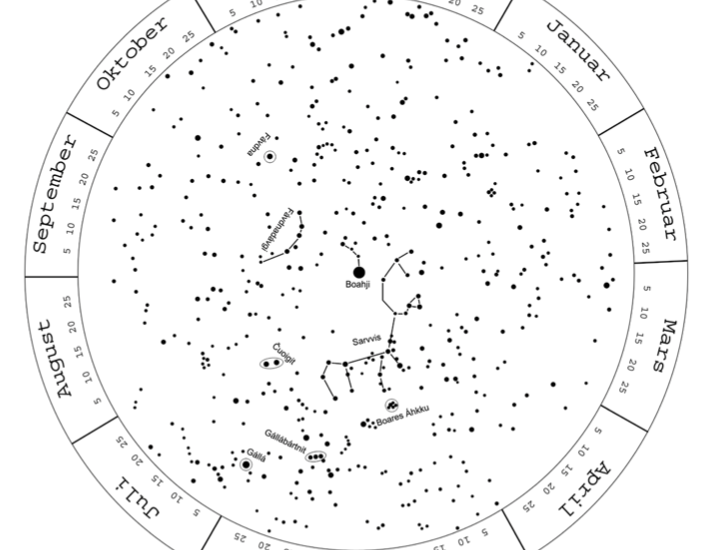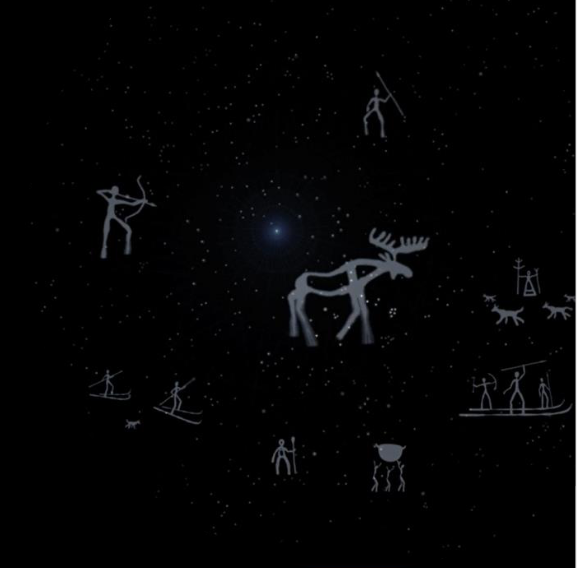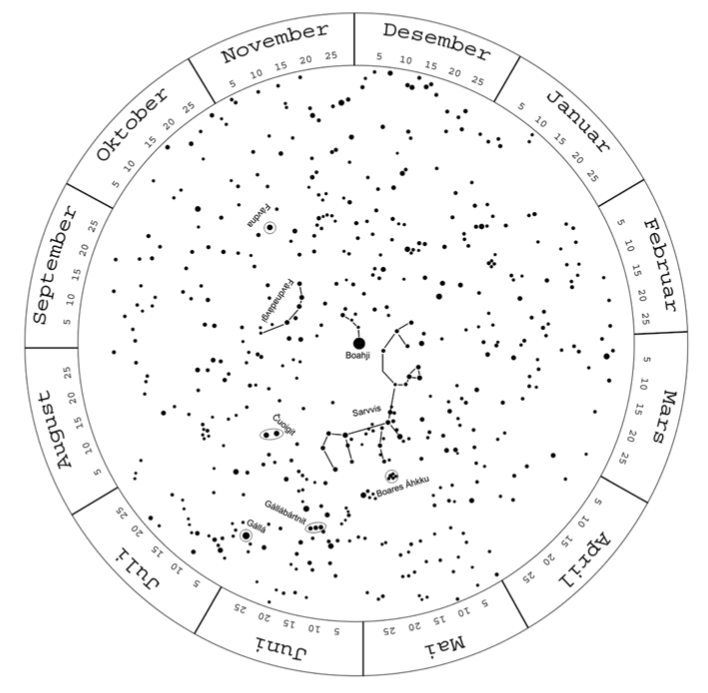THE STARRY SKY IN SÁPMI

 You are Reading..
You are Reading..
THE STARRY SKY IN SÁPMI
In the Sami tradition, the starry sky in Sápmi is a cosmic hunting scene. With a life in close contact with nature and a long winter/polar night. The Sami have developed a conscious relationship with the starry sky. The Sami have lived on reindeer herding and hunting, and the Sami constellations reflect this. We find the reindeer, hunters and hunting tools among the star constellations in the sky.
When a person who grew up in the north moves south, he will discover that the starry sky in the south deviates greatly from that found in the northern hemisphere. The area where the Sami and other northern people live is often called the Arctic. The explanation of this term includes not only the ecological aspect, but also the mythical. The name comes from the Greek word ‘arctus’, which means several things: 1. ‘bear’, 2. ‘north’ and 3. the constellation known internationally under the Latin name Ursa Major (Big Bear). Ursus is Latin for ‘bear’. The Greeks and some other peoples thought of Ursa Major as a bear. This star constellation is also called Storebjørn (big bear) in Norwegian.
Sami language and culture and Sami professions have changed over time, but the ideas from the old Samis about the universe and their own environment has persisted both in some sources and in the Sami worldview, especially in the tradition of the Sami who still use nature in their way of living.
“Sami reindeer herders are truly wise,” wrote the well-known Finnish author Samuli Paulaharju in 1925, after talking with a Sami reindeer herder, “they have a name for every single star, and if a star were to disappear, the Sami would immediately discover the loss“. The old Sami knew that such things in the starry sky as, for example, the bow, which refers to the ancient Sami tradition of hunting and trapping. During the hunting culture (until around the 17th – 18th centuries), hunting equipment consisted of bows, arrows, spears and knives.
The starry sky changes during the night. The stars appear in the east and move at night in the same direction as the sun. The exception is Boahji/Nuortanásti (North star), which can always be found in the same place. Some stars appear at certain times of the night, and they move across the sky to the west and disappear when the time is right. Other star constellations remain visible in the starry sky in the north (not in summer, of course), but they move in the same direction as the sun during the night.
The constellation Dávggát (Karlsvogna, Big Dipper) is visible in the starry sky all night, even if it gradually descends towards the horizon. The Sami people have used this star image as a clock since ancient times. The way it looks in northern Finland, Dávggát stands in the north in the middle of the night, directly above the head of the person looking up, but late at night the star image turns to the east and sets. When they calculated the time, they also took into account the seasons. The Inari Sami explain the different positions that Dávggát has during the months of a year in this way: In January, Dávggát stands in the east at midnight, in the southeast late at night and in the northwest in the morning.
The name Dávggát itself is not known throughout the Sami region, but in different areas of Sápmi they could have a different name for it.
The most important Sami constellation is Sarvvis – reindeer/wild reindeer/moose (Northern Sami: reindeer, wild reindeer or moose, Southern Sami and Eastern Sami: moose). Sarvvis is a large constellation that corresponds to many Greek constellations. The serrated antlers correspond to the constellation Cassiopeia and the legs form the constellations Perseus and the Coachman.
Various hunters hurriedly pursue this reindeer. This eternal cosmic hunt continues from ancient times until a star succeeds in killing the reindeer. If that happens, it’s the end of the world. The Sami have different mythical stories about who these hunters are and what the hunting animal in the starry sky is.
Fávdna, the star Arcturus, is one of the hunters who hunt Sarvvis. Fávdna uses a bow and arrow in the hunt and the bow is called Fávdnadávgi. It forms the handle of the big dipper and is always aimed at Sarvvis.
Other hunters are the three brothers Gállábártnit. You will recognize them as Orion’s belt in Greek mythology. They are known for their shooting skills and being the best skiers. They where the ones who invented the skis. With them they have a knife, spear and pot which you will find as the three stars under Orion’s belt.
The father of the Gállábártnit is called Gállá and is Sirius, the brightest star in our sky.
Boares Áhkku is an old woman with a pack of dogs. Together they make up the Greek constellation Pleiades. Their task is to scare Sarvvis and bring a pot to cook the meat in.
Čuoigit are two skiers who try to scare Sarvvis towards Fávdna. The skiers are the stars Castor and Pollux in Gemini from the Zodiac.
The Sami name for the North star is Boahji. It means the nail that holds the sky up (sky nail). It is always found in the same place regardless of the movement of the other stars, and has been given a special role in the cosmic hunting scene.
The Hunting Scene
The hunting scene itself begins in the early evening, where the hunters appear on the sky vault one by one. Fávdna stands ready with the bow Fávdnadávgi and aims at Sarvvis, while the other hunters, the skiers and his wife try to help so that Fávdna comes within range. Fávdna has drawn the bow, but does not dare to shoot because between him and Sarvvis stands Boahji, the nail of the sky. If it is hit, the sky will fall and all life on earth will cease. During a night of intense hunting, they realize that Sarvvis is too hard to catch. One by one the hunters have to give up, Gállá first and lastly Fávdna. This is how Sarvvis continues his grazing until the next day.

In this picture you can also see the three pot-bearers. They will collect the blood of Sarvvis when killed. And on the top is Fávdnas opponent with his spear. This picture is from this video: https://www.youtube.com/watch?v=rh4izdWP3XE
The following story about the hunt for the cosmic reindeer/moose was told to the Sámi student Berit Merete Nyhstad by the Kautokeino Sámi Oskal-Máhte Mihkkel Issát in the autumn of 1998.
“In the starry sky there is a big, fat and reindeer with antlers. This reindeer is being pursued by a large team. This time it is not a pack of wolves chasing the reindeer, but a whole team of hunters. Throughout the evening and night, one after the other joins the team hunting the reindeer. Behind the reindeer is Fávdna with her bow, Fávnnadávgi (Fávdná’s bow). There are also two skiers who are chasing the reindeer. Boares Áhkku and her two dog pups also want to join the hunt. She screams out to the pups : “Go chase, go chase! The fat rectum is the reward if you catch him!” This is how the old woman shouts to the dogs. She also has skis on her legs and speeds off to join the hunt. Gállábártnit, who are well-known hunters, also joins and pursues Sarvvis. They too have with them a hunting weapon, a bismer scale, and also a spear, a knife and a pot. A spear to stab and kill Sarvvis with, a knife to butcher with, and a pot to cook the fresh meat in. Boares Gállá has also set out to see how her sons, Gállábártnit, succeed in the hunt. Boahji (North star) is also in the hunt. Boahji will shoot Sarvvis. He also has a bow, and when he comes in reach and gets to shoot, then all the stars fall down and it will be the end of the world. But Sarvvis is constantly moving below. Boahji is so high up that he does not come within range, but he is on the lookout to see if Sarvvis does come within range, and then he will shoot to kill.”

Illustration: Naturfag.no
At first glance, this myth seem to tell about the end of the world, but there is still a deeper content in the myth. For most nature people, believing in the end of the world is a foreign thought. The end of life and Judgment Day are emphasized in the Christian faith, where time itself is also linear with a creation and an end of the world. For the ancient Sami, time was cyclical – without beginning and without end. They saw an eternal symbol in the eternal hunt and no foretelling of the end of life. From year to year, from century to century, from millennium to millennium, the cosmic hunters try to kill the great star animal. But this star animal always slipped safely past the hunters. No hunter manages to get closer – the reindeer/the moose – continues on its eternal journey. Time and life goes on, the structure of the universe does not change, and so it is an assurance that life is unceasing.
Sources for The Starry Sky in Sápmi:
- “Nokre samiske stjernebilete: Eit jaktfolks forestellingar om stjernehimmelen” by Jelena Sergejeva: https://www.mn.uio.no/astro/tjenester/publikum/almanakken/innhold/tema2001.html
- “Den samiske stjernehimmelen” by Wenche Erlien: https://www.naturfag.no/artikkel/vis.html?tid=815466
- “Den samiske stjernehimmlelen, Ikke en stjerne tapt” by Sara Gaup Vars. Atronomi 4/01
- Den samiske stjernehimmelen – en ressurs for tverrfaglig og stedsbasert læring i friluft by Mette Gårdvik, Karin Stoll & Wenche Sørmo
- https://www.youtube.com/watch?v=rh4izdWP3XE
Also read:

Wow, thank you for sharing this awesome knowledge! It makes the journeys in Sápmi even more beautiful.
Yes, amazing, right! Thank you for reading! 🙂 – Elin & Jungle.